Birds of the Adirondacks:
Northern Parula (Setophaga americana)
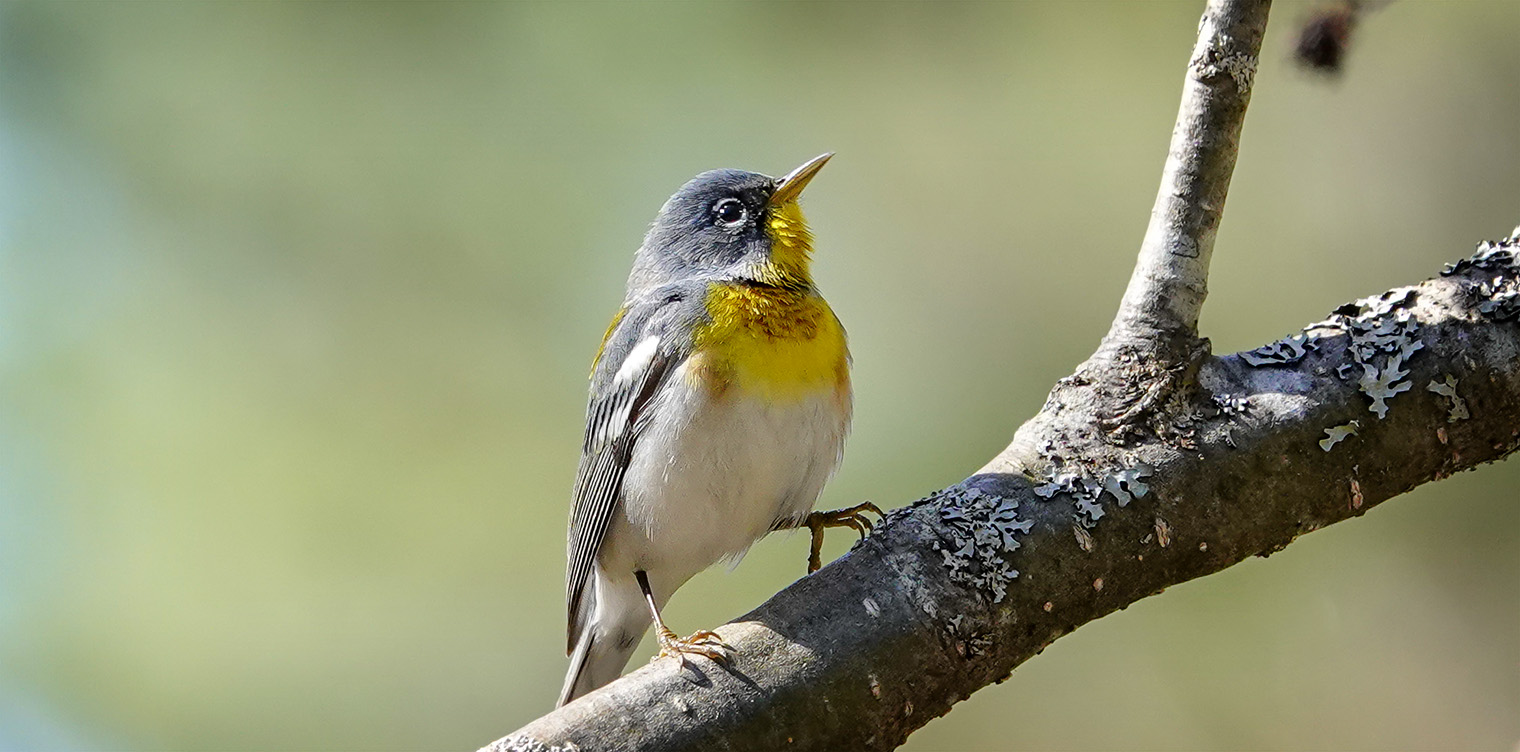
Northern Parulas (Setophaga americana) are small wood warblers with blue-gray upper parts, yellow breasts, and bright white eye crescents. This warbler breeds in the eastern US and Canada, including the Adirondack Mountains.
The Northern Parula is a member of the New World Warbler or Wood Warbler family (Parulidae). New World Warblers are small, primarily insect-eating songbirds which winter in warmer areas to the south and migrate north each spring to breed.
- The Northern Parula is currently assigned to the genus Setophaga, a large group which also includes many other warblers who breed in the Adirondacks, including the Palm Warbler, Cape May Warbler, Chestnut-sided Warbler, Blackburnian Warbler, and Yellow Warbler. The Northern Parula was previously assigned to the Parula genus. Its reassignment was part of a larger rearrangement of Wood Warbler taxonomy, based on DNA studies.
- Happily, the Northern Parula was allowed to retain its nonscientific name: Northern Parula. The word "parula" is a diminutive of titmouse.
- Other names for the Northern Parula include American Parula, Northern Parula Warbler, Parula Warbler, and Blue Yellow-backed Warbler. The latter name refers to the yellowish green patch on the bird's slate blue back. The bird's original name was Finch Creeper, a reference to its reported propensity to creep along tree tops.
Northern Parula: Identification
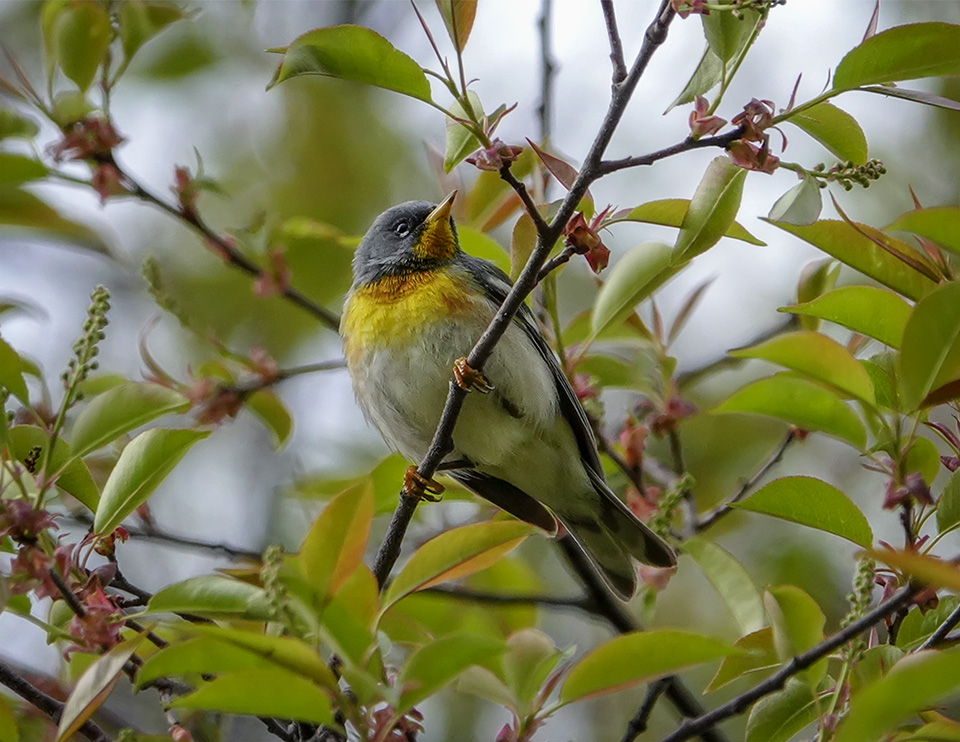
Keys to identifying the Northern Parula include its small size, blue-gray and yellow color combination, white wing bars, and prominent white eye crescents.
- The Northern Parula is one of the smallest of the Wood Warblers. It is 4.4 inches long, with an 8.3 inch wing span, weighing in at only 0.31 ounces. The Northern Parula is only marginally larger than the tiny Ruby-crowned Kinglet.
- The main colors to look for are blue-gray and yellow. Adults have a blue-gray back with a yellowish green patch. The throat is yellow; and the belly is white with no streaking.
- Northern Parulas sport a broken eye ring, often referred to in guide books as eye arcs or eye crescents.
- Another distinctive feature is the Northern Parula's bi-colored bill, which sets it apart from most other warblers. The lower mandible is yellow-orange.
- The Northern Parula's legs are dark. Its feet are pinkish yellow.
In spring, male Northern Parulas have a chestnut-orange breast band separating the bright yellow of the throat from the bright yellow of the breast. Females have a pattern similar to the male, but are duller overall. The breast band is absent or a very light chestnut in females. Immature Northern Parulas are similar to the adult female, but duller still.
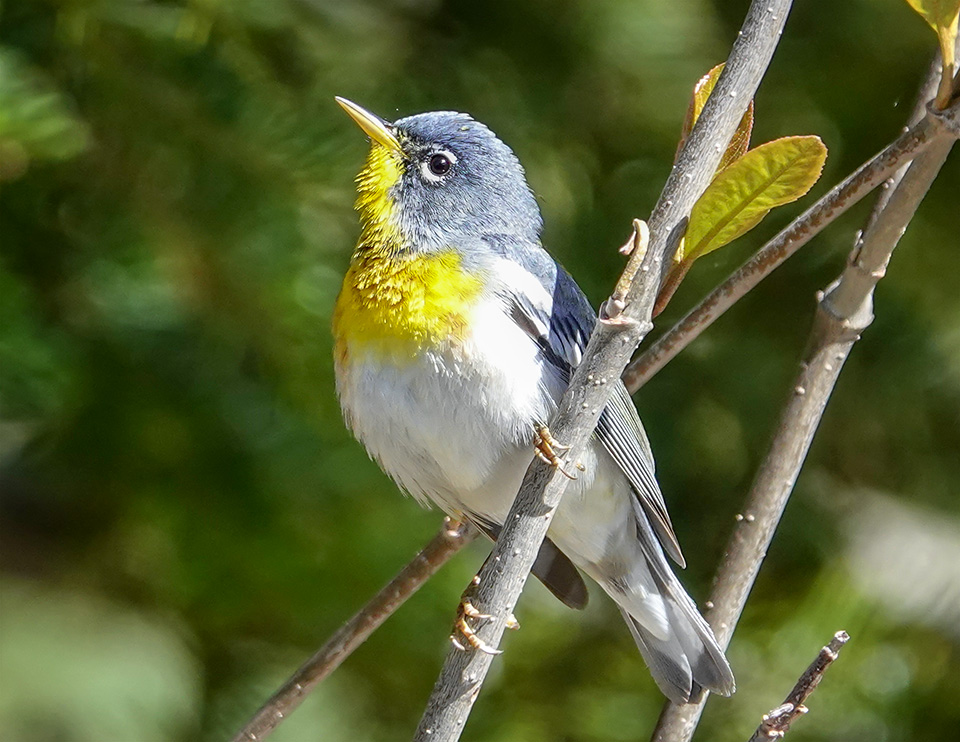
There are several other warblers that are somewhat similar in appearance to the Northern Parula. Adult male Nashville Warblers appear similar to adult male Northern Parulas. However, Nashville Warblers have a bright yellow belly, while Northern Parulas have a white belly. Moreover, Nashvilles lack the Northern Parula's bright white wing bars. Finally, the Nashville Warbler's complete eye ring contrasts with the Northern Parula's broken eye ring.
The Magnolia Warbler has more extensively yellow under parts than the Northern Parula. Moreover, the Nashville Warbler lacks the dark breast streaks of the Magnolia Warbler.
The Canada Warbler's upper parts are also blue, but it lacks the Northern Parula's green back patch and white wing bars. It also has a complete eye ring (as opposed to the Parula's eye arcs) and a distinctive necklace instead of the Northern Parula's colored breast bands.
The Black-throated Blue Warbler also has a blue head and back, but its face and throat are black, contrasting with the yellow throat and chest of the Northern Parula. The Black-throated Blue Warbler also lacks the Northern Parula's broken eye ring.
The Northern Parula's eye arcs and white belly also distinguish it from the Tropical Parula, which has similar plumage, but lacks the bright white eye crescents. In any event, the Tropical Parula's range does not extend to the Adirondack Mountains; it is found in south coastal Texas and along the Mexican border.
Northern Parula: Song and Calls
Northern Parulas sing two different songs.
- Their main song is a buzzy trill, ascending in pitch, dropping abruptly at the end.
- Their alternate song is a series of complex buzzy notes with a sharp, slurred ending.
Northern Parulas in the western part of their range tend to sing longer, less buzzy songs. Eastern singers have a higher trill rate than their western counterparts.
Some birders think that the Northern Parula's main song sounds rather like a zipper being pulled up quickly, remembering the song by characterizing the Northern Parula as the Zipper Bird. Others find it useful to remember the Northern Parula's main song by linking it with the mnemonic "Zeeeee-up."
As with many warblers, singing corresponds with the breeding cycle and is most intense in our area from May (the time the males arrive on their breeding grounds) through mid-July. Northern Parulas usually sing in the mid- and upper canopy, hopping and jumping from branch to branch and foraging while singing. Males sing during migration and throughout the nesting season.
The Northern Parula's call is a strong, clear chip. This bird's flight call is a high, descending "tsiip."
Northern Parula: Behavior
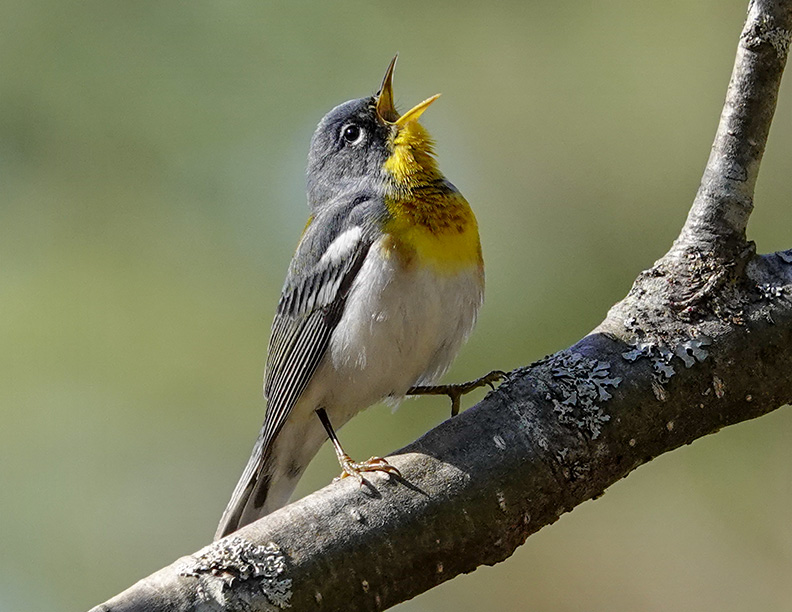
Northern Parulas are usually described as warblers of the upper canopy, most often seen on their breeding grounds flitting and hopping rapidly through the upper levels of the forest and sub-canopy. These birds are among those warblers who cause birders to complain of "warbler neck" – ache and stiffness in the neck and shoulders caused by spending an extended period of time looking up into the treetops. During migration, Northern Parulas tend to forage lower in the trees.
On their breeding grounds, Northern Parulas reportedly travel alone or in pairs. However, during migration and on their wintering grounds, they may form mixed flocks.
Northern Parula: Migration
Northern Parulas are long-distance migrants. They winter in Mexico, Central American, and the Caribbean. Their spring migration begins relatively early, but is prolonged. They begin leaving the Caribbean in February, returning to the southern part of their breeding grounds as early as March and to northern areas in May. Northern Parulas reportedly move mainly up the Atlantic coast during the spring migration.
This warbler leaves its breeding grounds beginning in August, with fall migration peaking in September through mid-October. The fall migration is also prolonged. The birds arrive on their wintering ground in late September through late October.
The pattern of eBird sightings within the Adirondack Park reflects these trends.
- Northern Parulas are rarely seen in the Adirondack region before early May. Most appear to arrive in mid- to late May.
- Records of eBird sightings within the Adirondack Park Blue Line suggest that Northern Parulas begin to leave their breeding grounds here in late August. Frequency declines further in September, with most of the September sightings clustered in early September.
- By late September and very early October, virtually all our Northern Parulas will have departed the Adirondack Mountains for their wintering grounds further south.
Northern Parula: Diet and Foraging
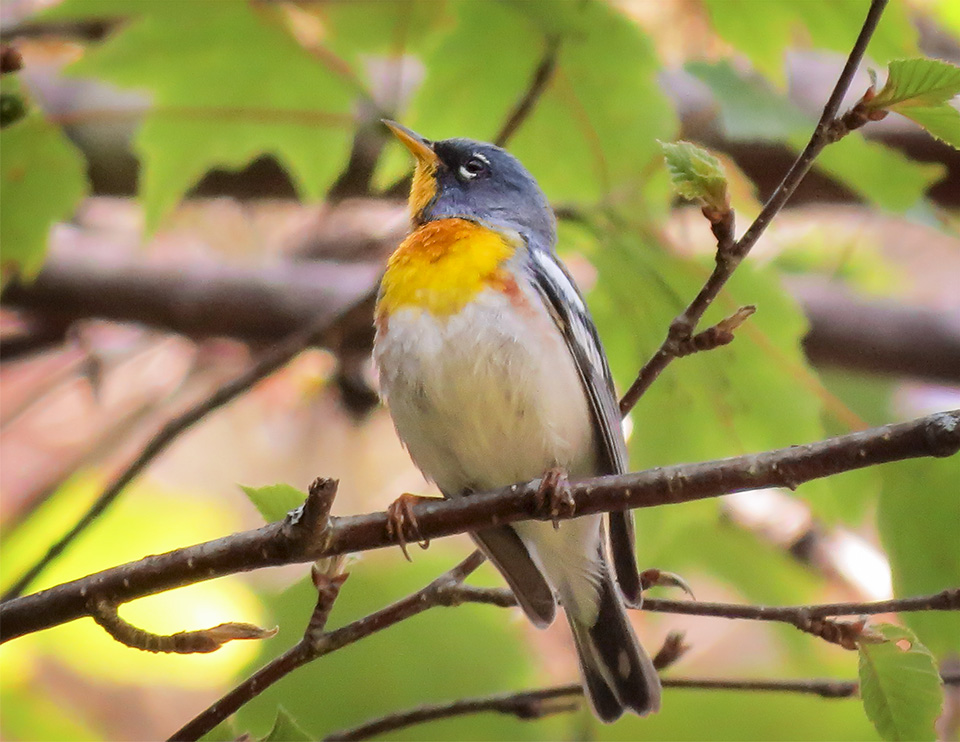
Like other warblers, Northern Parulas are primarily insect-eaters. Their diet consists of spiders and many kinds of insects, particularly caterpillars. Beetles, moths, ants, wasps, bees, flies, and locusts are also on the Northern Parula's menu during the breeding season. They may occasionally consume bud scales.
Insects and spiders also comprise the main items on their winter menu. However, they also eat berries, seeds, or nectar on their wintering grounds.
Northern Parulas are usually described as acrobatic feeders, often seen hanging upside down on twigs. They often forage at the tips of the foliage, taking advantage of the advantage offered by their small size, since heavier birds may have trouble navigating on this part of the tree.
The Northern Parula's foraging pattern depends on what other species are present. In areas where they are competing with the larger Yellow-rumped Warblers and Black-throated Green Warblers, the Northern Parula is usually found foraging at the ends of branches in the mid- and upper canopy. When these species are absent, the Northern Parula's foraging area expands to include the lower canopy and inner branches. They seem to prefer to forage in conifers rather than deciduous trees.
Northern Parula: Breeding and Family Life
Northern Parulas are generally monogamous. Males arrive on their breeding grounds before the females to establish territories. The birds are thought to pair up soon after arrival. In the Adirondack region, Northern Parulas apparently raise one brood per year, although birds who breed in the southern states may raise a second brood.
Northern Parulas build their nests, for the most part, in two different type of materials, at varying heights. In the southern part of their breeding range, they generally build nests in hanging bunches of Spanish moss. In the northern areas, including within the Adirondack Park Blue Line, they usually build nests in Usnea lichen (Old Man's Beard), hollowing out a cup near the bottom with an entrance hole in the side.
Northern Parulas lay three to five eggs. Generally, only the female incubates. The incubation period is 12 to 14 days. Parental care is provided mainly by the female, with some male assistance in feeding and nest cleaning. Young Northern Parulas leave the nest 10 to 11 days after hatching, but remain close to their parents for an unknown period of time.
Distribution of the Northern Parula
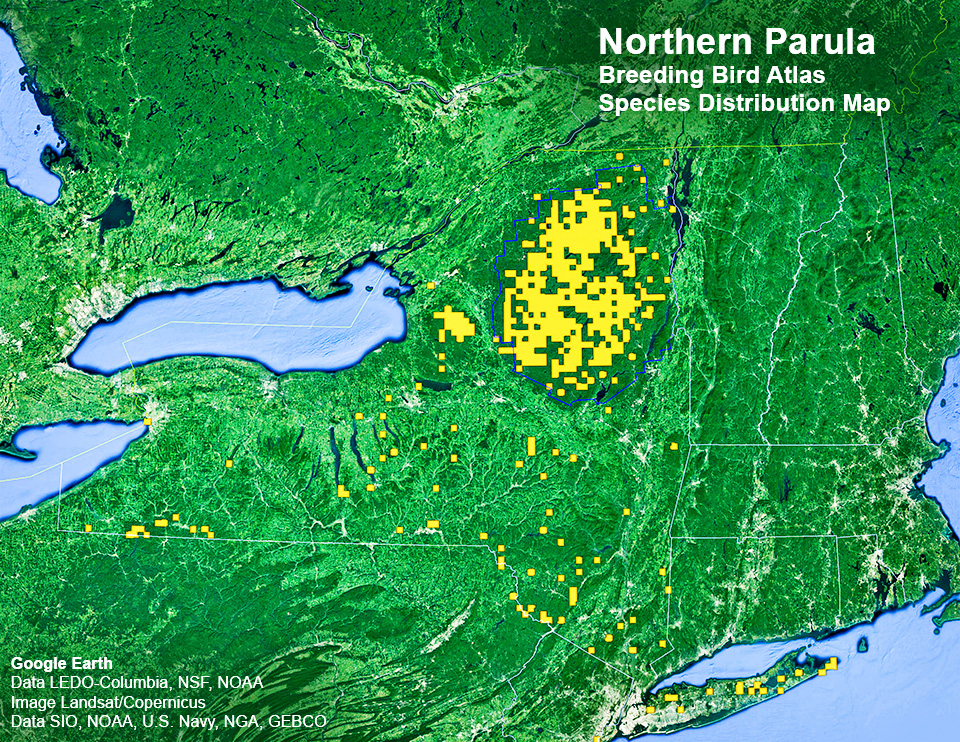
Northern Parulas breed in the forests of eastern North America, from southeastern Manitoba and Nova Scotia south to the Gulf Coast and northern Florida. However, there is a large gap in their breeding territory. One part of the Northern Parula's breeding range covers the northeastern and upper midwestern United States and Canada. The southern part of their breeding grounds covers the southeastern US, skipping parts of Iowa, Wisconsin, Michigan, and some states in the Northeast, including southern New Hampshire, Massachusetts, Rhode Island, Connecticut, and New Jersey.
The reason for this gap in the Northern Parula's breeding grounds is not clear. It is thought to be connected with habitat loss associated with the negative impact of air pollution on the growth of the moss Northern Parulas use as nesting material.
The distribution of breeding Northern Parulas within New York State is consistent with this explanation. These birds apparently bred throughout the state through the late 19th century, although the bird was thought to be more abundant as a breeding species on Long Island and in the Catskill and Adirondack areas. Northern Parulas suffered a decline in population after 1900, becoming more restricted to the Adirondacks.
- The first New York State breeding bird survey (1980-1985) found that most breeding pairs in the state were found within the Adirondack Park Blue Line, with a few possible breeding sites in the Tug Hill area and scattered sites downstate and in the Finger Lakes area.
- The 2000-2005 Breeding Bird Survey found a much larger number of breeding pairs, concentrated in the Adirondack Mountains, with another cluster in the Tug Hill area and a few individual sites scattered outside the Blue Line, including the Finger Lakes area and Long Island.
- Results from the first year of the current New York State Breeding Bird Atlas suggest a similar pattern, with most of the confirmed and probable sightings concentrated in the Adirondacks.
The population of Northern Parulas in North America appears to be secure. Partners in Flight estimates that the global population is about 17 million breeding adults, with a 62% increase in population between 1970 and 2014. The Partners in Flight Bird Conservation Plan for the Adirondack Mountains concludes that population trends in the Adirondacks are stable.
Northern Parula: Habitat
The Northern Parula's breeding habitat varies.
- They reportedly breed in deciduous, coniferous, or mixed woodlands in the northern part of their range, preferring moist woods and swamps where Beard Lichen (Usnea lichen) is found.
- In the southern part of their range, Northern Parulas apparently favor deciduous woodland where Spanish Moss (Tillandsia) is abundant.
- In New York State, this warbler nests in open hardwood or conifer forests and swamps, with nesting locations generally limited to places with Usnea lichen.
However, breeding Northern Parulas are occasionally found in areas where neither Usnea lichen or Spanish Moss is available. During migration and on their tropical wintering grounds, Northern Parulas use many habitat types.
Where to find Northern Parulas in the Adirondacks
Adirondack Birding Sites for Northern Parulas
- High Peaks Region
- Riverside Drive
- Chubb River Swamp
- Silver Lake Bog
- West-Central Region
- Moose River Plains
- Third Lake Creek
- South Inlet
- Raquette Lake Inlets
- Beaver Lake
- Northern Region
- Whitney Wilderness
- Five Ponds Wilderness
- Peavine Swamp
- Floodwood Road
- Saranac Lake Village
- California Road & Debar Pond
Source: John M.C. Peterson and Gary N. Lee. Adirondack Birding. 60 Great Places to Find Birds (Lost Pond Press, 2008).
Adirondack birders in search of Northern Parulas have a variety of birding sites to choose from, particularly in the northern and west-central regions, as listed in Peterson and Lee's Adirondack Birding guide. Their list of birding sites for Northern Parulas includes the Nature Conservancy's Silver Lake Bog Preserve in Clinton County, the Moose River Plains and South Inlet area in Hamilton County, and Five Ponds Wilderness in St. Lawrence County.
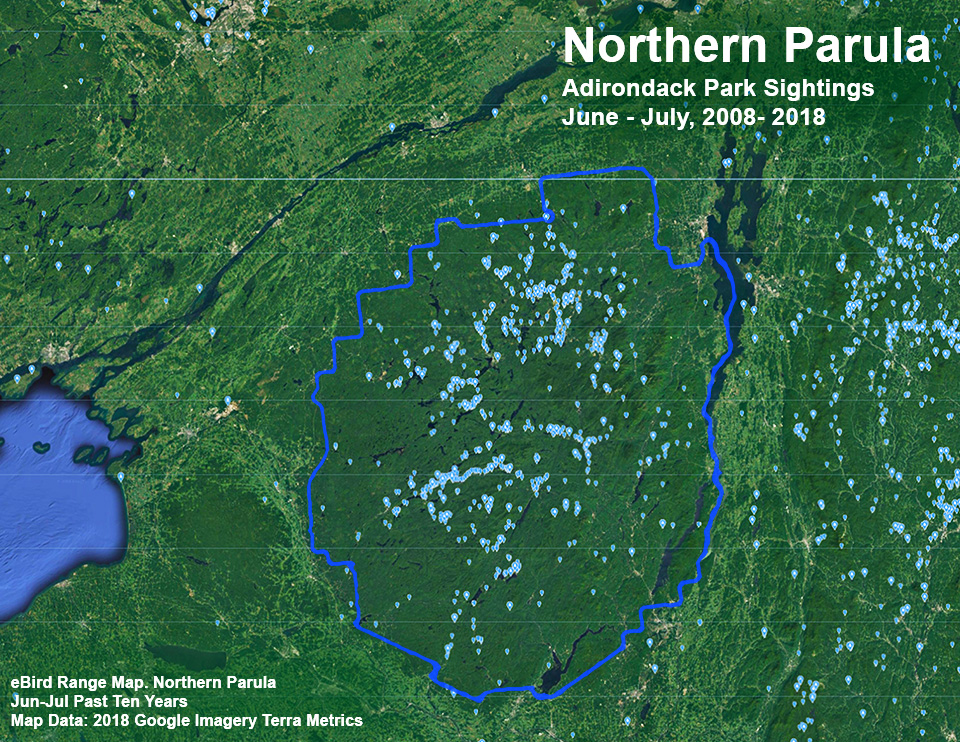
The pattern of eBird checklists during the breeding season (June-July), suggests that Adirondack birders looking for Northern Parulas can find them throughout the Adirondack Park.
- Northern Parula sightings appear to be concentrated in the interior of the Blue Line, with fewer sightings in the Eastern Adirondack foothills, Champlain Valley, and Western Adirondack transition area.
- There are clusters of sightings around some of the locations suggested in the Peterson/Lee book, including the Silver Lake Bog Preserve, Saranac Lake Village, and the area around Inlet.
It is interesting to note that few eBird sightings of the Northern Parula have been recorded in the past decade for the Tug Hill area, where a cluster of possible and probable breeding sites was found in the 2000-2005 New York State Breeding Bird Survey.
- This may reflect the fact that this area has attracted few eBirders in the past decade.
- Alternately, it could indicate a shift in Northern Parula breeding patterns.
The New York State Ornithological Association is embarking on a third breeding bird survey, which will begin in 2020. Results from that project should provide data to test these two alternative (although not necessarily mutually exclusive) hypotheses.
Among the trails covered here, likely locations to look for Northern Parulas include the damp areas on the edges of the fields at the John Brown Farm Trails, most of the trails at the Paul Smith's College VIC, and the northern portions of the Bloomingdale Bog Trail (between the Bloomingdale-Gabriels Road and Bigelow Road).
References
American Ornithological Society. Checklist of North American Birds. Northern Parula. Setophaga americana. Retrieved 2 December 2018.
Avibase. The World Bird Database. Northern Parula. Setophaga americana. Retrieved 2 December 2018.
Cornell Lab of Ornithology, Ithaca, New York. All About Birds. Northern Parula. Setophaga americana. Retrieved 2 December 2018.
Cornell Lab of Ornithology, Ithaca, New York. Birds of the World. Subscription Web Site. Northern Parula. Setophaga americana. Retrieved 20 March 2021.
Cornell Lab of Ornithology, Ithaca, New York. Macaulay Library. Northern Parula. Setophaga americana. Retrieved 1 December 2018.
Cornell Lab of Ornithology, Ithaca, New York. eBird. An Online Database of Bird Distribution and Abundance. Bird Observations. Northern Parula. Retrieved 3 December 2018.
Cornell Lab of Ornithology, Ithaca, New York. eBird. An Online Database of Bird Distribution and Abundance. Species Maps. Northern Parula. Retrieved 11 November 2018.
Xeno-canto Database. Northern Parula. Setophaga americana. Retrieved 1 December 2018.
USGS. Longevity Records of North American Birds. Northern Parula. Retrieved 9 December 2018.
Boreal Songbird Initiative. Guide to Boreal Birds. Northern Parula. Parula americana. Retrieved 9 December 2018.
Audubon. Guide to North American Birds. Northern Parula. Setophaga americana. Retrieved 9 December 2018.
Bird Watcher's Digest. Bird Identification Guide. Northern Parula. Setophaga americana. Retrieved 9 December 2018.
New York State. Department of Environmental Conservation. New York State Breeding Bird Atlas: Species Distributions Map (Google Earth). Northern Parula. Retrieved 2 December 2018.
New York State. Department of Environmental Conservation. New York State Breeding Bird Atlas: Species Distribution Map, 1980-1985. Release 1.0. Updated 6 June 2007. Release 1.0. Updated 11 June 2011. Northern Parula. Retrieved 9 December 2018.
New York State. Department of Environmental Conservation. New York State Breeding Bird Atlas: Species Distribution Map, 2000-2005. Release 1.0. Updated 11 June 2011. Northern Parula. Retrieved 9 December 2018.
Kevin J. McGowan, "Northern Parula. Parula americana," in Kevin J. McGowan and Kimberley Corwin (Eds). The Second Atlas of Breeding Birds in New York State (Cornell University Press, 2008), pp. 478-479, 639.
John M.C. Peterson, "Northern Parula. Parula americana," in Robert F. Andrle and Janet R. Carroll (Eds.) The Atlas of Breeding Birds in New York State (Cornell University Press, 1988). pp. 366-367.
New York Breeding Bird Atlas III. Species Map. Northern Parula. Retrieved 20 March 2021.
New York Breeding Bird Atlas III. Hints on Haunts. Retrieved 8 April 2021.
Geoffrey Carleton. Birds of Essex County, New York. Third Edition (High Peaks Audubon Society, 1999), p. 34.
Charles W. Mitchell and William E. Krueger. Birds of Clinton County. Second Edition (High Peaks Audubon Society, 1997), pp. 8-9, 19-21, 97.
Alan E. Bessette, William K. Chapman, Warren S. Greene and Douglas R. Pens. Birds of the Adirondacks. A Field Guide (North Country Books, Inc., 1993), p. 173
John M.C. Peterson and Gary N. Lee. Adirondack Birding. 60 Great Places to Find Birds (Lost Pond Press, 2008), pp. 70-72, 78-80, 85-87, 92-94, 98-104, 111-113, 134-144,150-157, 178-180, 209.
Adirondack Park Agency. Checklist of Birds of the Adirondack Park Visitor Interpretive Center at Paul Smiths, NY. Undated.
J. R.Sauer, D. K. Niven, J. E. Hines, D. J. Ziolkowski, Jr, K. L. Pardieck, J. E. Fallon, and W. A. Link. 2017. The North American Breeding Bird Survey, Results and Analysis 1966 - 2015. Version 2.07.2017. USGS Patuxent Wildlife Research Center, Laurel, MD. Retrieved 6 November 2018.
J. R.Sauer, D. K. Niven, J. E. Hines, D. J. Ziolkowski, Jr, K. L. Pardieck, J. E. Fallon, and W. A. Link. 2017. The North American Breeding Bird Survey, Results and Analysis 1966 - 2015. Trend Estimate by Species. Northern Parula. Setophaga americana. Version 2.07.2017. USGS Patuxent Wildlife Research Center, Laurel, MD. Retrieved 10 December 2018.
Vermont Atlas of Life. Vermont Breeding Bird Species Profiles. Northern Parula. Setophaga americana. Retrieved 10 December 2018.
Mass Audubon. Breeding Bird Atlas 2. Species Accounts. Northern Parula. Parula americana. Retrieved 10 December 2018.
S.C.G. Haas, "Northern Parula (Setophaga americana)," in A.T. Chartier, J.J. Baldy, and J.M. Brenneman, Eds. The Second Michigan Breeding Bird Atlas. Kalamazoo Nature Center. Kalamazoo, Michigan, USA. Retrieved 10 December 2018.
Wisconsin Breeding Bird Atlas 1. Species Maps. Northern Parula. Retrieved 10 December 2018.
Minnesota Breeding Bird Atlas. Northern Parula. Setophaga americana. Retrieved 10 December 2018.
Partners in Flight. Partners in Flight Science Committee 2013. Population Estimates Database, version 2013. Northern Parula. Setophaga americana. Retrieved 10 December 2018.
Partners in Flight. Partners in Flight Landbird Conservation Plan. 2016 Revision for Canada and Continental United States, p. 111. Retrieved 23 November 2018.
Partners in Flight. Bird Conservation Plan for the Adirondack Mountains, p. 27. Retrieved 23 November 2018.
David Allen Sibley. Sibley Birds East. Second Edition (Alfred A. Knopf, 2016), p.351.
David Allen Sibley. The Sibley Guide to Birds. Second Edition (Alfred A. Knopf, 2014), p. 484.
Roger Tory Peterson. Peterson Field Guide to Birds of Eastern and Central North America. Sixth Edition (Houghton Mifflin Harcourt, 2010), pp. 268-269.
Donald and Lillian Stokes. The New Stokes Field Guide to Birds. Eastern Region (Little, Brown and Company, 2013), p. 369.
Jonathan Alderfer, Ed. Complete Birds of North America. Second Edition (National Geographic, 2014), pp. 608-609.
Richard Crossley. The Crossley ID Guide (Princeton University Press, 2011), p. 401.
American Museum of Natural History. Birds of North America. Revised Edition (Dorling Kindersley Limited, 2016), p. 587.
John Bull and John Farrand, Jr. Eds. National Audubon Society Field Guide to North American Birds. Eastern Region. Second Edition (Alfred A. Knopf, 1994), p. 662, Plates 520, 521.
Edward S. Brinkley. National Wildlife Federation Field Guide to Birds of North America (Sterling Publishing Co., Inc., 2007), p. 372.
Tom Stephenson and Scott Whittle. The Warbler Guide (Princeton University Press, 2013), pp. 20-21, 35, 39-40, 42, 48-49, 96-97, 171, 188, 191, 237, 285, 348, 366-371, 415, 494, 499, 501, 511, 525, 538, 542, 547.
Chris G. Earley. Warblers of the Great Lakes Region & Eastern North America (Firefly Books, 2003), pp. 30-33.
Frank M. Chapman. The Warblers of North America. Third Edition (D. Appleton & Company, 1907), pp. 104-109.
Jon Curson, David Quinn and David Beadle. Warblers of the Americas. An Identification Guide (Houghton Mifflin Company, 1994), pp. 29-29, 106-107.
Jon L. Dunn and Kimball L. Garrett. A Field Guide to Warblers of North America (Houghton Mifflin Company, 1997), pp. 56-57, 195-203.
Douglass H. Morse. American Warblers: An Ecological and Behavioral Perspective (Harvard University Press, 1989), pp. 31, 66-70, 109-110, 291-291.
Alexander Sprunt, Jr., "Parula W," in Ludlow Griscom, Alexander Sprunt, Jr. et al., Eds. The Warblers of North America (The Devin-Adair Company, 1957), pp. 28, 97-98, Plate 7.
Arthur Bent. Life Histories of North American Wood Warblers. Part One and Part Two (Smithsonian Institution. United States National Museum. Bulletin 203, 1953), pp. 135-147. Kindle Book. Retrieved 13 November 2018.
Paul Sterry. Warblers and Other Songbirds of North America: A Life-size Guide to Every Species (Harper-Collins Publishers, 2017), p. 205.
iNaturalist. Adirondack Park Sightings. Northern Parula. Retrieved 11 December 2018.
Aretas A. Saunders. The Summer Birds of the Northern Adirondack Mountains. Roosevelt Wild Life Bulletin. Volume 5. Number 3 (September 1929), pp. 326-499. Retrieved 2 March 2017.
Theodore Roosevelt, "The Summer Birds of the Adirondacks in Franklin County, N.Y.," Roosevelt Wild Life Bulletin, Volume 5. Number 3 (September 1929), pp. 501-504. Retrieved 2 March 2017.
Perley M. Silloway, "Relation of Summer Birds to the Western Adirondack Forest," Roosevelt Wild Life Bulletin, Volume 1, Number 4 (March 1923), pp. 396-486. Retrieved 2 March 2017.
Elon Howard Eaton. Birds of New York (New York State Museum, 1914), pp. 395-397. Retrieved 12 November 2018.
C. Hart Merriam, "Preliminary List of Birds Ascertained to Occur in the Adirondack Region. Northeastern New York," Bulletin of the Nuttall Ornithological Club, Volume 6, Number 4 (October 1881), pp. 225-235. Retrieved 10 December 2018.
Ralph R. Moldenhauer, "Two Song Populations of the Northern Parula," The Auk. A Quarterly Journal of Ornithology. Volume 109, Number 2 (April 1992), pp. 215-222. Retrieved 11 December 2018.
Douglass H. Morse, "Competitive Relationships Between Parula Warblers and Other Species During the Breeding Season," The Auk. A Quarterly Journal of Ornithology. Volume 84, Number 4 (October-December 1967), pp. 490-503. Retrieved 11 December 2018.
David Sibley. The New Wood-Warbler Taxonomy. 23 June 2011. Retrieved 12 December 2018.
